| Author |
Message |
Gavin Kisebach

|
 Posted: Sun 10 Feb, 2008 1:44 am Post subject: Blackening a haft Posted: Sun 10 Feb, 2008 1:44 am Post subject: Blackening a haft |
 |
|
I'm in the process of building a Danish axe, and I'm wondering if there is a historic method of staining a haft black or at least very dark. The head for the axe is complete, and I had the maker leave the body oxidized, i.e. black. The cutting edge is bright and shiny, though you can't see it in this picture. Sorry, my camera is broken, I had to use the web cam  . .
I'll be adding a brass sheathing like the one on the original, but to both ends of the haft. If time and money allow I'm going to have an associate of mine, Travis Conn, make the caps and perhaps do some repousse decoration as well.
Anyhow I think the brass caps and the black axe head would look sharp with a blackened haft, but I'm not sure how to go about it. If It's not just right I'll probably skip it. The haft will be made from oak.
I was thinking of an soot / linseed oil mix worked into the wood, which I think would blacken the wood, but it might just make it look like crap. Or I could char the surface with a heat gun, but that might come out very blotchy and uneven. Alternately, I could just leave the darned haft alone. Any thoughts?
 Attachment: 119.39 KB Attachment: 119.39 KB
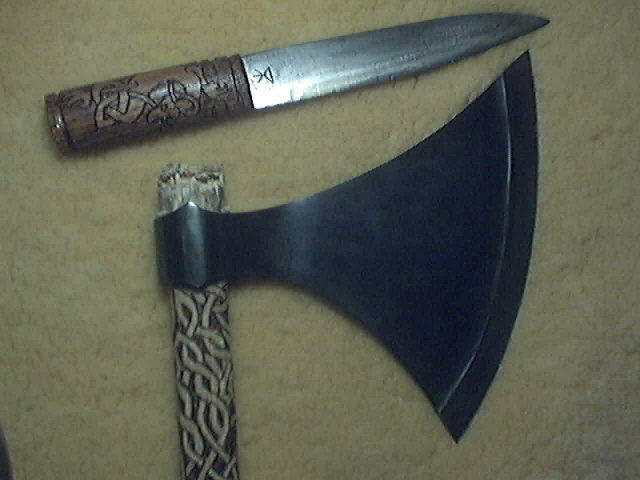
 Attachment: 79.18 KB Attachment: 79.18 KB
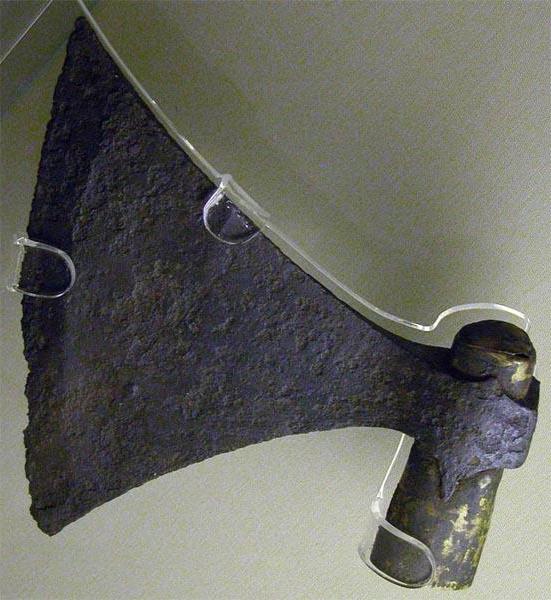
|
|
   |
 |
|
Ken Speed
|
 Posted: Sun 10 Feb, 2008 8:15 am Post subject: Posted: Sun 10 Feb, 2008 8:15 am Post subject: |
 |
|
Gavin,
It would help to know what kind of wood you are planning to stain because different woods respond differently to different techniques.
A "traditional technique" for blackening wood is to use iron oxide and it isn't terribly difficult. First get or make some rusty iron. You can make some rusty iron by getting some fine steel wool wet and then letting it sit out in the air for a couple of days. Then immerse the rusty iron in vinegar in a loosely covered jar (a tightly capped container could rupture from the gas generated from the chemical reaction) and allow it to sit for a week or more. The vinegar will work on the rust to create a stain (this is the same as the black marks you see on wood exposed to the weather that has been nailed with untreated nails). When you apply this liquid to the wood it will react to the tannin in the wood and cause the wood to turn gray and when this wood is coated with a clear finish the gray will change to black. Be sure to try this on a scrap before you do your haft because you may or may not like the results and the color you obtain will be determined by the amount of tannin in the wood. This should give you a good strong result on ash, red oak or white oak. If, on there open pored woods, the mixture doesn't penetrate the pores add a little liquid dish soap to the mixture to break the surface tension of the water.
Make sure the wood is clean and has no oil, wax or old finish to block the stain and wet the wood and let it dry and then resand it with fine sandpaper before you use the iron oxide because the water in the vinegar will raise the grain on the wood. I'd put at least a sealer coat of finish on the haft before adding any metal just to be safe.
I've used this in a couple of different ways on furniture I've built and read that this is a technique which goes back to colonial times but I don't know if the Vikings or Saxons knew how to do this.
Let me know if this works for you, if it doesn't I can suggest some less traditional stains that may suit you better.
Ken Speed
|
|
  |
 |
Leo Todeschini
Industry Professional

|
 Posted: Sun 10 Feb, 2008 10:34 am Post subject: Posted: Sun 10 Feb, 2008 10:34 am Post subject: |
 |
|
I am totally with Ken,
sand the haft and dampen it, get a local metal shop to sweep their floor for you and get a nice pile of iron/steel dust (grinder dust works great) and rub it into the wood and leave to dry. Do this a few times and it will seriously darken up. Oak and chestnut will go black with one application and lower tannin woods take more, but the effect is so simple and obvious there is no way our forefathers didn't know about it, the only question is did they do it deliberately - I would guess on occassion probably.
It also works a treat on veg tanned leather
I actually sent a load of floor sweepings to a book binder once......
Tod
www.todsworkshop.com
www.todcutler.com
www.instagram.com/todsworkshop
https://www.facebook.com/TodsWorkshop
www.youtube.com/user/todsstuff1
|
|
   |
 |
|
Ken Speed
|
 Posted: Sun 10 Feb, 2008 4:18 pm Post subject: Posted: Sun 10 Feb, 2008 4:18 pm Post subject: |
 |
|
Tod,
You wrote, "... the effect is so simple and obvious there is no way our forefathers didn't know about it, the only question is did they do it deliberately ..." Oh, I don't know I had this really hideous picture of them wiping blood into the hafts of their axes
etc.  Actually they might have done that too. Milk paint was pretty commonly colored using animal blood in the colonial era. Actually they might have done that too. Milk paint was pretty commonly colored using animal blood in the colonial era.
I'll remember that it works on vegetable tanned leather, thanks for the tip. I use an adaptation of this for accentuating the figure in tiger maple.
Best,
Ken Speed
|
|
  |
 |
Merv Cannon

|
 Posted: Sun 10 Feb, 2008 11:57 pm Post subject: Axe photo Posted: Sun 10 Feb, 2008 11:57 pm Post subject: Axe photo |
 |
|
Hi Gavin.............Just wondering if you have any details on that second photo which is obviously a Museum shot
....do you know which Museum ?
Thanks .
Merv
Merv ....... KOLR
http://www.lionrampant.com.au/
"Then let slip the dogs of war ! "......Woof !
|
|
   |
 |
Gavin Kisebach

|
 Posted: Mon 11 Feb, 2008 12:42 am Post subject: Posted: Mon 11 Feb, 2008 12:42 am Post subject: |
 |
|
I wish I had more details. I believe it was from the Royal Armoury, but memory fails. Such is the peril of saving every image you come across without labeling . 
|
|
   |
 |
Sean Flynt

|
|
   |
 |
Gavin Kisebach

|
 Posted: Mon 11 Feb, 2008 2:32 pm Post subject: Posted: Mon 11 Feb, 2008 2:32 pm Post subject: |
 |
|
Thanks so much Sean, I couldn't for the life of me figure out where I had found that picture. Do you have any details on where the axe was found, or what era it is from? Obviously it's late viking era, Petersen type M, but with a nice forward sweep that I tried to duplicate with my own axe.
I thought the brass haft cap was very intriguing as well. I have seen this on at least two other axes; my theory is that the soft metal helps the axe head stay tight while also protecting the haft. This cap is relatively plain. I have seen other examples that had extensive circle and dot patterning.
|
|
   |
 |
|
S. Christiansen
Location: South Jutland, Denmark Joined: 25 Aug 2007
Posts: 79
|
 Posted: Mon 11 Feb, 2008 2:54 pm Post subject: Posted: Mon 11 Feb, 2008 2:54 pm Post subject: |
 |
|
| Gavin Kisebach wrote: | | Thanks so much Sean, I couldn't for the life of me figure out where I had found that picture. Do you have any details on where the axe was found, or what era it is from? Obviously it's late viking era, Petersen type M, but with a nice forward sweep that I tried to duplicate with my own axe. |
I guess the other two you've seen are the ones in the attached images below? Here's some information on them, taken from www.museumoflondonprints.com:
Picture 1
Date:
960 AD - 1060 AD
Full image caption:
Triangular axe blade with eared socket. The bronze tube remains in upper part of the handel. This axe blade is decorated with interlaced pattern. It is part of a group of battle axes and spears that were found during building works at the north end of London Bridge in the 1920s. They may have been lost in battle or thrown into the river by the victors in celebration. In the late 900s and early 1000s Scandinavian rulers like Swein Forkbeard of Denmark and Olaf Tryggvason of Norway tried to gain control of the Danelaw and of the rest of England, and eventually Swein’s son Cnut won the English throne. There were a number of battles along the Thames and around London Bridge.
Picture 2
Date:
1000 AD - 1060 AD
Full image caption:
Viking weapons from the Thames. Selection of iron axes and spearheads. The wooden handles are modern additions. In the late 900s and early 1000s Scandinavian rulers like Swein Forkbeard of Denmark and Olaf Tryggvason of Norway tried to gain control of the Danelaw and of the rest of England, and eventually Swein’s son Cnut won the English throne. There were a number of battles along the Thames and around London Bridge. On one occasion the bridge was pulled down. These battle axes and spears were found during building works at the north end of London Bridge in the 1920s. They may have been lost in battle or thrown into the river by the victors in celebration.
 Attachment: 15.24 KB Attachment: 15.24 KB
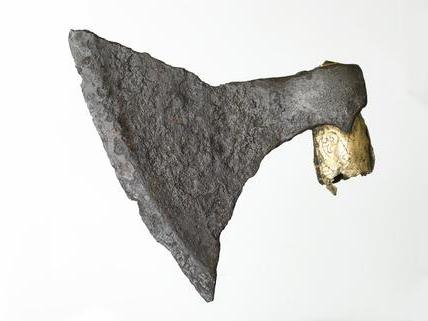
 Attachment: 74.17 KB Attachment: 74.17 KB
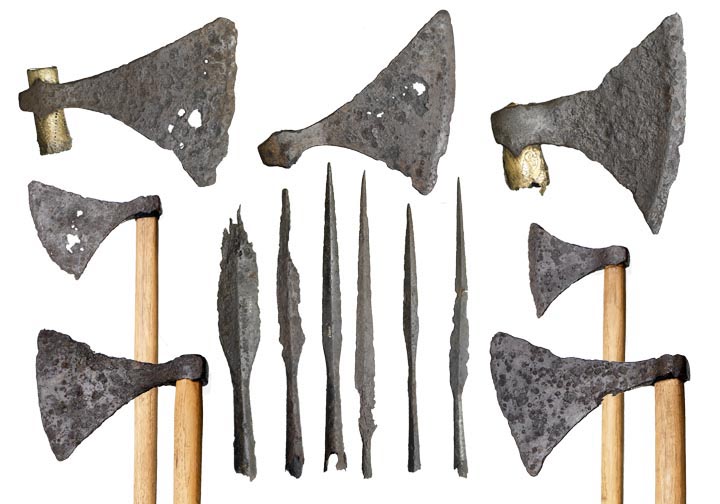
Regards,
Sonni
|
|
   |
 |
Gavin Kisebach

|
 Posted: Mon 11 Feb, 2008 3:28 pm Post subject: Posted: Mon 11 Feb, 2008 3:28 pm Post subject: |
 |
|
Actually I've never seen that site before, but it's great  thanks for sharing. thanks for sharing.
Here are a couple more unsourced photos (probably Seans) and I think there are also a couple examples in Osprey's Viking Herseir.
This is a great idea, IMO. I've noticed that the last six to ten inches of an axe haft (just below the head) tends to get torn up relatively quickly, because this area is always hitting the rim of the enemy's shield. It makes a lof of sense to reinforce this area. I use a strip of rawhide on my axes, but brass is much cooler.
 Attachment: 34.12 KB Attachment: 34.12 KB
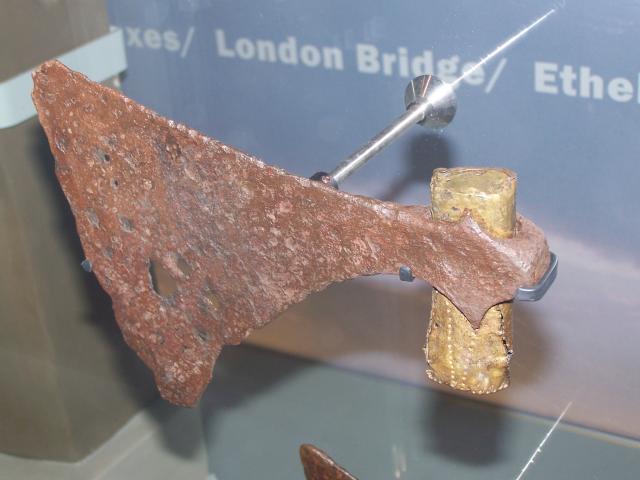
 Attachment: 32.77 KB Attachment: 32.77 KB
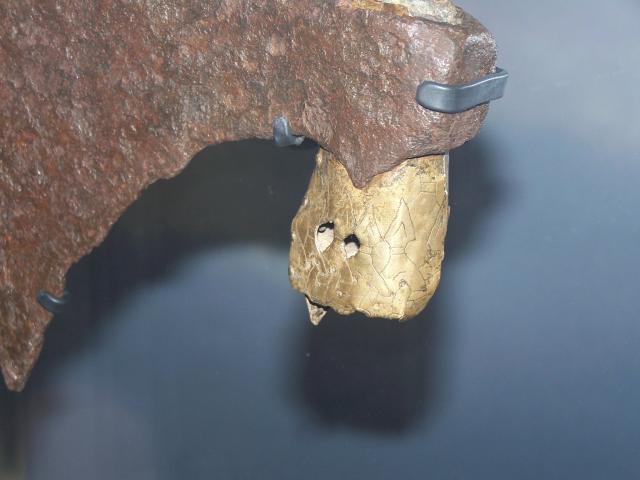
|
|
   |
 |
Sean Flynt

|
 Posted: Tue 12 Feb, 2008 6:27 am Post subject: Posted: Tue 12 Feb, 2008 6:27 am Post subject: |
 |
|
Those aren't my photos, but the axes do seem to correspond with those shown in the nice prints above.
As for the brass cap. Waldman mentions that the great weakness of these long-hafted axes was that a blow causes tremendous stress just below the socket. Eventually, smiths lengthened the lower end of the blade and pinned it to the haft in order to distribute some of that stress. I wonder if the cap is an intermediate attempt to do the same thing. Brass/bronze/latten is so soft, though. Why not use iron?
-Sean
Author of the Little Hammer novel
https://www.amazon.com/Little-Hammer-Sean-Flynt/dp/B08XN7HZ82/ref=sr_1_1?dchild=1&keywords=little+hammer+book&qid=1627482034&sr=8-1
|
|
   |
 |
|
S. Christiansen
Location: South Jutland, Denmark Joined: 25 Aug 2007
Posts: 79
|
 Posted: Mon 18 Feb, 2008 9:35 am Post subject: Posted: Mon 18 Feb, 2008 9:35 am Post subject: |
 |
|
| Sean Flynt wrote: | | Eventually, smiths lengthened the lower end of the blade and pinned it to the haft in order to distribute some of that stress. I wonder if the cap is an intermediate attempt to do the same thing. Brass/bronze/latten is so soft, though. Why not use iron? |
That's a good point. Obviously it served a cosmetic purpose, otherwise I don't think they would have chosen those metals, and certainly not decorated it the way they did, unless they thought it would strengthen the haft as well as looking good?
Regards,
Sonni
|
|
   |
 |
Gavin Kisebach

|
 Posted: Thu 21 Feb, 2008 6:50 pm Post subject: Posted: Thu 21 Feb, 2008 6:50 pm Post subject: |
 |
|
As I mentioned in another thread, this does seem to be a major point of wear for a long axe. The rest of the haft seems to eat vibration pretty well, but I've never tried it with oak or ash. I think this makes a lot of sense if you are trying to preserve the life of the haft.
Well mostly because I've not seen iron used at this juncture in history. Perhaps this is the embryonic state of langettes. My friend who will be assisting me with the brass also wondered about the functionality of the brass:
| Quote: | My guess is that this cap thing is to keep the haft from
splitting when the wedge is driven, as evidenced by the taper at the
wedge end. This theory is out the window if the tube is capped of
course, and I can't tell from the photo. If there is no cap then we're
just making a tube, which is fairly easy. |
But the end is clearly capped. My thought was that perhaps it is a brass tube with a flap attached. You could hammer in the wedge, then fold down the cap. how it would stay folded down from there is beyond my ken. I don't know if there is some historic equivalent of tack welding for brass, but I doubt it.
|
|
   |
 |
|
Johan S. Moen
Location: Kristiansand, Norway Joined: 26 Jan 2004
Posts: 259
|
 Posted: Thu 21 Feb, 2008 11:21 pm Post subject: Posted: Thu 21 Feb, 2008 11:21 pm Post subject: |
 |
|
The pictures of the last axe make it looke like the brass tube is put on the haft, a brass disk is put on top of the haft, and the rim of the tube is hammered down on the disk. You can see some vague triangular shapes along the upper edge of the tube that might be securing the top.
Johan Schubert Moen
|
|
  |
 |
|
|

